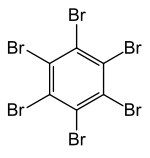Hexabromobenzene
Hexabromobenzene is an aromatic compound. It is a derivative of benzene in which all hydrogen atoms are replaced by bromine atoms.
 | |
| Names | |
|---|---|
| IUPAC name
Hexabromobenzene | |
Other names
| |
| Identifiers | |
3D model (JSmol) |
|
| ChemSpider | |
| ECHA InfoCard | 100.001.613 |
PubChem CID |
|
| UNII | |
CompTox Dashboard (EPA) |
|
| |
| |
| Properties | |
| C6Br6 | |
| Molar mass | 551.490 g·mol−1 |
| Appearance | Monoclinic needles or white powder.[1] |
| Odor | Odorless[2] |
| Melting point | 327 °C (621 °F; 600 K) [2] |
| 0.16x10−3 mg/L (insoluble)[1] | |
| Solubility | Slightly soluble in Ethanol, Diethyl ether[3] |
| Solubility in Acetic acid | Soluble[3] |
| Solubility in Benzene | 10%[4] |
| Solubility in Chloroform | 10%[4] |
| Solubility in Petroleum ether | 10%[4] |
| log P | 6.07[1] |
| Hazards | |
| Safety data sheet | LCSS 6905 |
| GHS pictograms |  |
| GHS Signal word | Danger[2] |
GHS hazard statements |
H302, H312, H315, H319, H332, H335, H413[1] |
| P261, P264, P270, P271, P280, P301+312, P302+352, P304+312, P304+340, P305+351+338, P312, P321, P322, P330, P332+313, P362, P363, P403+233, P405, P501[1] | |
| NFPA 704 (fire diamond) | |
Except where otherwise noted, data are given for materials in their standard state (at 25 °C [77 °F], 100 kPa). | |
| Infobox references | |
Hexabromobenzene has seen use in high voltage capacitors as a flame retardant.[5] It also has applications as a starting material in the formation of thin graphene-like films for low cost energy storage devices and capacitors.[6]
References
- CID 6905 from PubChem
- Record in the GESTIS Substance Database of the Institute for Occupational Safety and Health
- Weast, R.C. (1979). Handbook of Chemistry and Physics (60 ed.). Boca Raton, Florida: CRC Press Inc. p. C-165. ISBN 9780849315565.
- Weast, Robert C.; Astle, Melvin J. (1985). CRC Handbook of Data On Organic Compounds. 1. Boca Raton, Florida: CRC Press Inc. p. 176. ISBN 9780849304002.
- US Grant 6909590, Tsukasa Sato, Isao Fujiwara, Makoto Morita, Kenichi Horikawa, "High voltage capacitor and magnetron", published 2004-08-09, issued 2005-06-21, assigned to TDK Corp
- Kudaş, Züleyha; Gür, Emre; Ekinci, Duygu (11 June 2018). "Synthesis of Graphene-like Films by Electrochemical Reduction of Polyhalogenated Aromatic Compounds and their Electrochemical Capacitor Applications". Langmuir. 34 (27): 7958–7970. doi:10.1021/acs.langmuir.8b01177. PMID 29890834.
This article is issued from Wikipedia. The text is licensed under Creative Commons - Attribution - Sharealike. Additional terms may apply for the media files.
